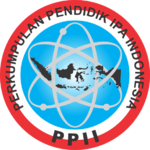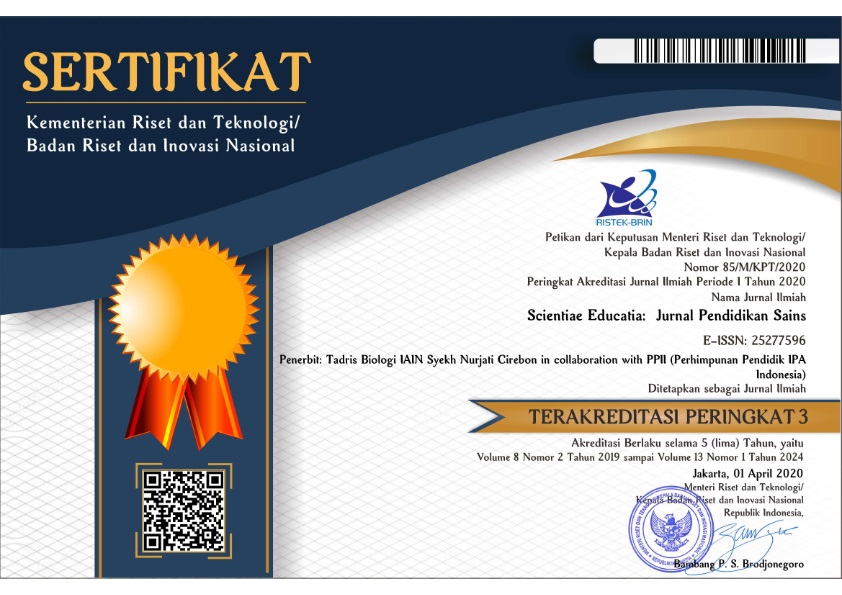Problem-Based Learning Supported with Experiment Media Based on the Internet of Things to Enhance the Students’ HOTS Ability
(1) Masters of Physics Education Study Program, Postgraduate, Universitas Negeri Semarang
(2) Masters of Physics Education Study Program, Postgraduate, Universitas Negeri Semarang
(3) Masters of Physics Education Study Program, Postgraduate, Universitas Negeri Semarang
(*) Corresponding Author
Abstract
Keywords
Full Text:
PDFReferences
Afrizal, M. A. (2018). Rancang bangun rumah pintar berbasis IoT(Internet of Things) sebagai media pembelajaran pada mata pelajaran pemrograman, mikroprosesor, dan mikrokontroller di SMKN 2 Surabaya. Jurnal Pendidikan Teknik Elektro, 7(1), 79-86.
Alrikabi, H. T. S., Nasser, K. W., & Alaidi, A. H. M. (2020). The application of wireless communication in IoT for saving electrical energy. International Journal of Interactive Mobile Technologies, 14(1), 152–160.
Arifin, Z. (2016). Evaluasi Pembelajaran: Prinsip, Teknik, Prosedur. Bandung: PT Remaja Rosdakarya Offset. Bandung.
Ariyana, Y., Pudjiastuti, A., Bestary, R., & Zamroni. (2019). Buku Pegangan Pembelajaran Berorientasi pada Keterampilan Berpikir Tingkat Tinggi. Jakarta: Dirjen GTK Kemdikbud.
Artono, B., & Putra, R. G. (2017). Penerapan Internet of Things (IoT) untuk kontrol lampu menggunakan arduino berbasis web. Jurnal Teknologi Informasi Dan Terapan, 5(1), 9-16.
Azizah, D. N., Sutopo, & Zulaikah, S. (2017). Identifikasi pemahaman konsep siswa SMA pada materi termodinamika. Prosiding Seminar Pendidikan IPA Pascasarjana UM, 2, 134-142. Malang: Universitas Negeri Malang.
Campbell, D. T., & Stanley, J. C. (2015). Experimental and quasi-experimental designs for research. Ravenio Books.
Christensen, W. M., Meltzer, D. E., & Ogilvie, C. A. (2009). Student ideas regarding entropy and the second law of thermodynamics in an introductory physics course. American Journal of Physics, 77(10), 907-917.
Dinatha, N. M., & Kua, M. Y. (2019). Pengembangan modul praktikum digital berbasis Nature Of Science (NOS) untuk meningkatkan Higher Order Thinking Skill (HOTS). Journal of Education Technology, 3(4), 293-300.
Georgiou, H. (2014). Doing Positive Work: On student understanding of thermodynamics. The University of Sydney.
Georgious, H., & Sharma, M. D. (2015). Does using active learning in thermodynamics lectures improve students’ conceptual understanding and learning experiences? European Journal of Physics, 36(1), 015020.
Gómez, J., Huete, J. F., Hoyos, O., Perez, L., & Grigori, D. (2013). Interaction system based on Internet of things as support for education. Procedia Computer Science, 21, 132-139.
Goovaerts, L., De Cock, M., Struyven, K., & Dehaene, W. (2019). Developing a module to teach thermodynamics in an integrated way to 16-year-old pupils. European Journal of STEM Education, 4(1), 1–11. https://doi.org/10.20897/ejsteme/3964
He, J. (Selena), Chia, D., Lo, T., Xie, Y., & Lartigue, J. (2016). Integrating Internet of things (IoT) into STEM undergraduate education: A case study of a modern technology infused courseware for embedded system course. Proceedings - Frontiers in Education Conference, FIE, 2016-Novem, 1–9. https://doi.org/10.1109/FIE.2016.7757458
Kemdikbud. (2016). Silabus Mata Pelajaran Sekolah Menengah Atas/Madrasah Aliyah (SMA/MA). Jakarta: Kementerian Pendidikan dan Kebudayaan.
Layali, S., & Kartika, I. (2015). Pengembangan alat praktikum termodinamika berbasis problem based learning. Kaunia, 11(2), 136-143.
Malik, A., Novita, Y., & Nuryantini, A. Y. (2019). Enhancing critical thinking skills of students related to temperature and heat topics through problem solving-laboratory model. Jurnal Penelitian & Pengembangan Pendidikan Fisika, 5(1), 9-20.
Muchlis, F., Sulisworo, D., & Toifur, M. (2017). Pengembangan alat peraga fisika berbasis internet of things. Jurnal Pendidikan Fisika Unversitas Muhammadiyah Makasar, 6(1), 13-20.
Musyafak, A., Linuwih, S., & Sulhadi. (2013). Konsepsi alternatif mahasiswa fisika pada materi termodinamika. Unnes Physics Education Journal, 2(3).
Preciado Babb, A. P., Saar, C., Friesen, S., & Brandon, J. (2014). Engaging high school students in an engineering thermodynamics project. IEEE Global Engineering Education Conference, EDUCON, 222–228.
Prihatmoko, D. (2016). Penerapan Internet of Things ( IoT ) dalam pembelajaran di UNISNU Jepara. Simetris : Jurnal Teknik Mesin, Elektro Dan Ilmu Komputer, 7(2), 567-574.
Puspendik. (2019). Laporan Penguasaan Materi Ujian Nasional. Jakarta: Kementerian Pendidikan dan Kebudayaan.
Ramadhani, R., Umam, R., Abdurrahman, A., & Syazali, M. (2019). The effect of flipped-problem based learning model integrated with LMS-google classroom for senior high school students. Journal for the Education of Gifted Young Scientists, 7(2), 137-158.
Ramos, J. L. S., Dolipas, B. B., & Villamor, B. B. (2018). Higher-Order thinking skills and academic performance in physics of college students: A regression analysis. International Journal of Innovative Interdisciplinary Research,4(4), 48-60.
Religia, R., & Achmadi, H. R. (2017). Pengembangan KIT Sederhana stirling engine pada materi termodinamika sebagai media pembelajaran fisika SMA. Jurnal Inovasi Pendidikan Fisika, 6(3), 113-119.
Rusydi, R. (2017). Pembelajaran berbasis masalah (PBM) pada materi termodinamika untuk meningkatkan kemampuan kognitif dan kemampuan kreatif (kreativitas) mahasiswa FTK UIN Ar-Raniry Banda Aceh. Jurnal IPA & Pembelajaran IPA, 1(2), 192-202. https://doi.org/10.24815/jipi.v1i2.9694
Saputra, R. H., & Hertanto, D. B. (2018). Media berbasis teknologi internet of things ( iot ) mata pelajaran teknik mikroprosesor di kelas X Audio Video SMK N 3 Yogyakarta. E-Journal Universitas Negeri Yogyakarta, 8(2), 131-138.
Saputro, V. C. E., Prabowo, & Admoko, S. (2019). Pengembangan alat peraga mesin carnot sebagai media pembelajaran dengan model pembelajaran inkuiry terbimbing. IPF : Inovasi Pendidikan Fisika, 08(02), 716-721.
Sari, D. M., Surantoro, & Ekawati, E. Y. (2013). Analisis Kesalahan dalam Menyelesaikan Soal Materi Termodinamika pada Siswa SMA. Jurnal Materi Dan Pembelajaran Fisika (JMPF), 3(2), 33-39.
Sears, & Salinger. (2013). Thermodynamics, Kinetic Theory, and Statistical Mechanics. In Addison-Wesley Publishing Company.
Tatar, E., & Oktay, M. (2011). The effectiveness of problem-based learning on teaching the first law of thermodynamics. Research in Science and Technological Education, 29(3), 315-332.
Widoyoko, E. P. (2017). Teknik Penyusunan Instrumen Penelitian. (6 th ed). Yogyakarta: Pustaka Belajar.
Zimmermann, & Torsten. (2018). Industry 4.0: Nothing is More Steady than Change. In Smart Grid Analytics for Sustainability and Urbanization. USA: IGI Global.
DOI: 10.24235/sc.educatia.v9i1.6452
Article Metrics
Abstract view : 134 timesPDF - 30 times
Refbacks
- There are currently no refbacks.
Scientiae Educatia: Jurnal Pendidikan Sains indexed by:

This work is licensed under a Creative Commons Attribution 4.0 International License.



1.png)












